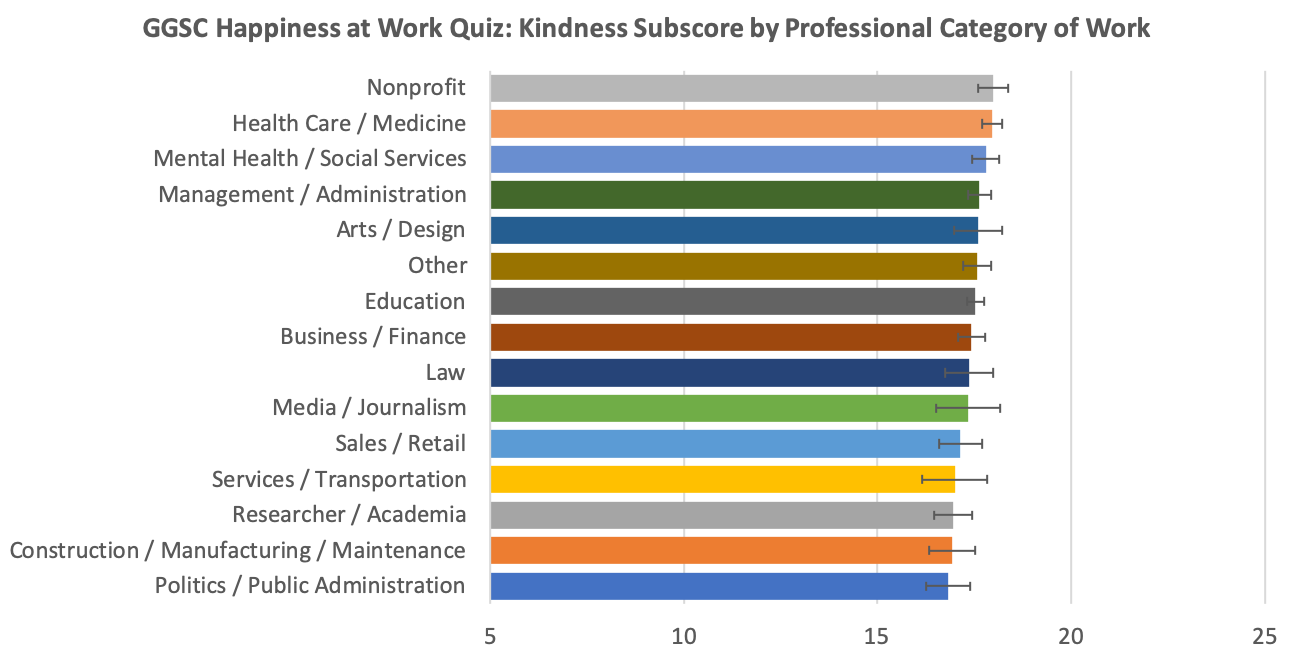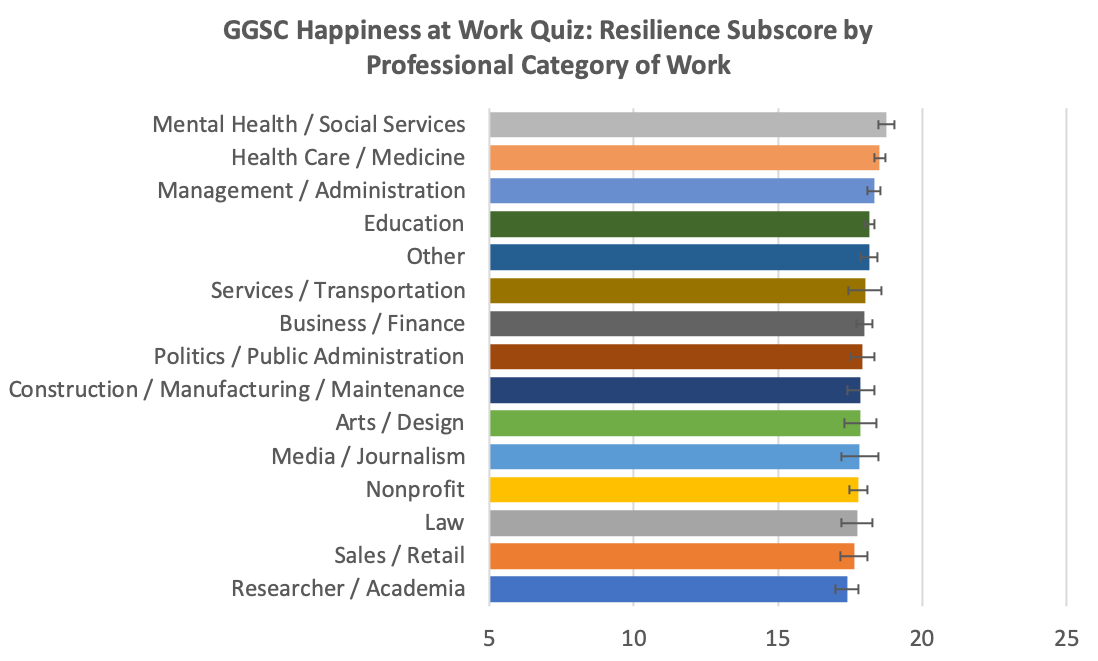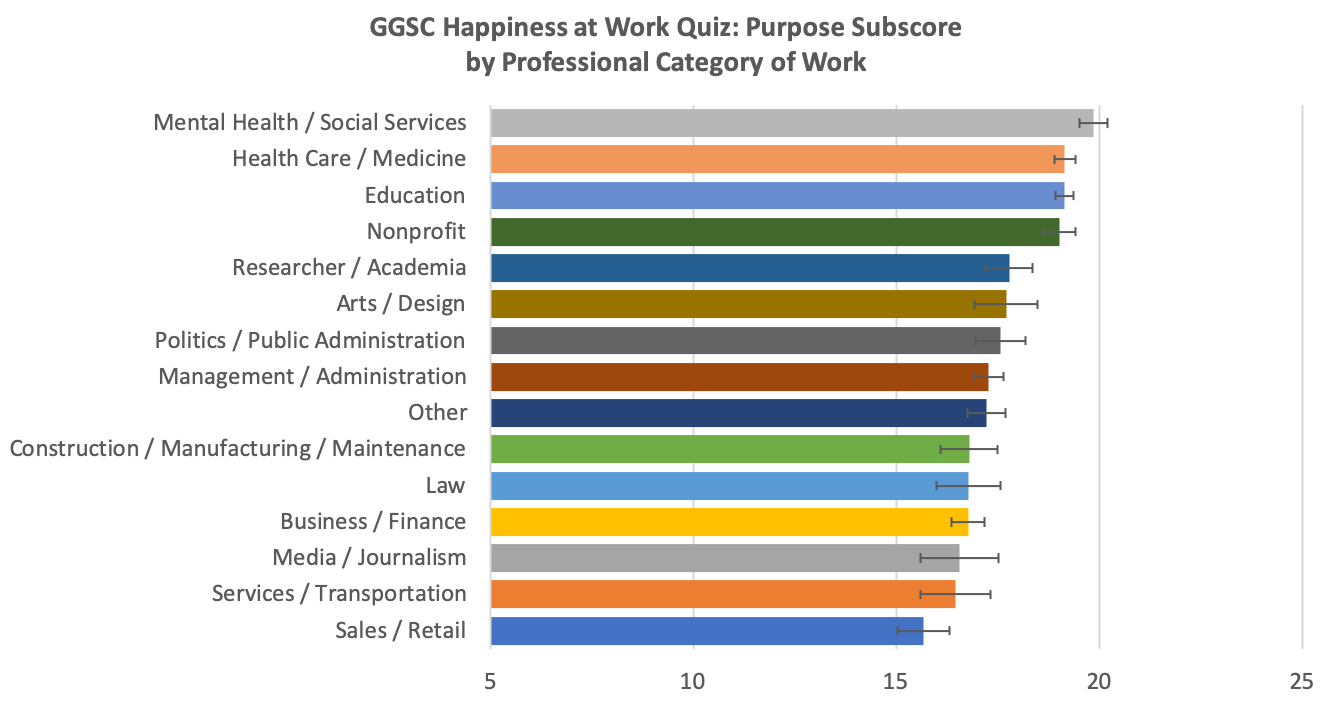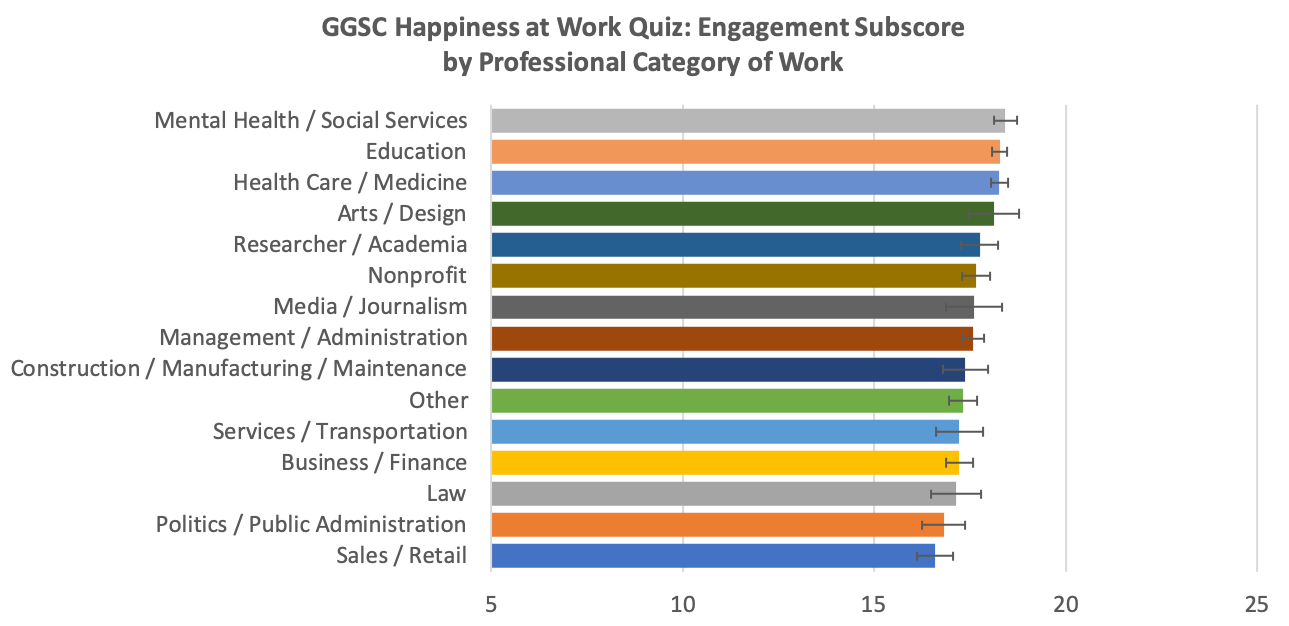Most of us would like to be happier at work—to be able to say that the hours and effort that we dedicate to it truly contribute to how happy we are in life.

How do we get there? Like happiness overall, happiness at work does not mean trying to be cheerful and enthusiastic all the time. According to research, workplace happiness is much deeper. In the Greater Good Science Center’s series of courses on the Science of Happiness at Work, we offer an organizing framework—called PERK—that distills happiness at work into key constructs that can be strengthened:
- Purpose: Feeling that your work aligns with core values and meaningfully contributes to something beyond yourself.
- Engagement: Feeling curious, interested, and inspired; experiencing flow; and being dedicated to making progress at work.
- Resilience: Being able to handle setbacks and difficulties in ways that foster learning and growth at work.
- Kindness: A trusting, friendly, and genuinely supportive social climate at work.
Our happiness at work quiz is based on the PERK framework, and we have analyzed data from just under 6,000 of the first respondents who took it. People’s average happiness at work is an underwhelming 72 out of 100 (which is worse than it sounds, considering that the lowest possible score is 20). The findings offer not just a snapshot of workplace well-being among our international quiz-takers, but also some promising opportunities for increasing happiness at work.
1. Everyone could use a little more kindness at work
When people report kindness at work, that includes both acting kindly toward others and being treated with kindness. Among the four aspects of workplace happiness, kindness was rated the lowest, at an average of 70.3—and it’s also the aspect that seems to be least affected by industry or position. In other words, kindness may primarily be determined by the culture that coworkers create together, not the nature of the work itself.
In our quiz, we asked people to indicate what industry they work in (e.g., construction or law) and what their work role is (support staff, middle management, etc.). Not surprisingly, people working in nonprofits and health care—where caring is part of their mission—tended to report more kindness at work. And people with greater freedom, power, or money—including the self-employed, the highest earners, and people in upper management—also reported more kindness. This may be because people in higher-paying leadership roles receive more courtesy and deference from others, or because (in the case of the self-employed) they have more choice of whom to work with.

But these differences were relatively small. There was more variability in kindness within industries and work roles—which is good news for those of us who aren’t nonprofit employees or CEOs. This suggests we all have some wiggle room.
According to several studies of positive practices at work led by Kim Cameron at the Michigan Center for Positive Organizational Scholarship, the respectful, friendly, and supportive behaviors that comprise kindness are trainable, like any other habit. We can practice to get better at them, in any context—even work.
Leaders can evaluate their own warmth or relational energy—how inspired and invigorated (versus drained and depleted) people feel after interacting with them—and get training to improve their interpersonal skills. Organizations can boost kindness by offering training in compassion, while individuals can try helpful practices like these:
- Random Acts of Kindness, which involves purposefully doing something to delight someone else a few times a day at work.
- Capitalizing on Positive Events in conversations with colleagues, by asking them about uplifting experiences they had and affirming the positive implications of them.
- Expressing gratitude at work in a descriptive, heartfelt way, whether verbal or written.
- Reminders of Connectedness, a reflection exercise that can help coworkers foster common humanity and team spirit, sentiments that make kindness easier to come by.
Despite the stereotype of the cutthroat workplace, more kindness at work is possible and worth pursuing. Our happiness at work quiz results suggest that most workplaces are not explicitly prioritizing or training kindness as a skill or value (even in professions that are steeped in kindness), despite its notable benefits to happiness at work.
2. We can do better at resilience at work
Our respondents’ resilience at work—although slightly higher than kindness, at 72.6 on average—showed a similar pattern: There were only minor differences between industries and roles.
As with kindness, it was people in health care, as well as workers with greater freedom and status, who reported the most resilience. However, that wasn’t true of nonprofit workers; it’s hard to say why this should be the case without more data. Meanwhile, a wide variety of industries and job roles showed similar levels of resilience. For example, people in services or transportation were as resilient as people in business or finance, and skilled laborers were just as resilient as trained professionals.

This pattern of scores suggests that people are probably relying on the minimum resilience necessary to function in whatever workplace setting they’re in. The data do not suggest that particular workplaces are encouraging and training their employees in resilience, even though all occupations come with some kind of stress. With deliberate attention and investment, there is ample room to grow.
One practice that can strengthen resilience is to ask for help at work, so that your list of tasks and responsibilities feels less overwhelming and you feel more supported by your colleagues. Research by Stanford’s Francis J. Flynn shows that we routinely underestimate other people’s interest in and willingness to help us, and an abundance of research shows that being helpful to others is fundamentally rewarding. Despite our judgmental inner chatter, people appreciate and derive meaning from lending a hand at work.
A second option is to join the wave of organizations and companies that are incorporating mindfulness into everyday work to create cultures of clarity, authenticity, and care. Practicing mindfulness can be as simple as taking a deep, slow breath on your way into a tense negotiation, or as complex as offering codified, company-wide mindfulness sessions during the workday.
One obstacle to resilience is workaholism, which, according to experts like Jeffrey Pfeffer, causes crushing stress while offering no advantages to productivity. Organizational behavior experts are increasingly highlighting the importance of work-life harmony—that is, striking a healthy balance between time and effort at work, and detaching or taking time away from work. Studies highlight the benefits of downtime activities, including vacation, for our long-term well-being at work.
3. We can learn from naturally purposeful professions
Compared to the three other domains, our respondents’ feelings of purpose at work were the highest—and they were also the most similar to their overall happiness at work. This suggests that, when we think about well-being on the job, our own values and our job’s contribution to society are incredibly important.
Purpose seems to come naturally to certain professions and roles. Our respondents had the greatest purpose when they worked in health and human services, or in more senior roles. People with less prestigious, stable, and autonomous jobs, like in sales and retail or temporary work, scored lowest on a sense of purpose.

If you’re working in a helping profession—caring for others day-to-day—it’s probably easy to see how your work contributes to society. For the rest of us, maintaining a sense of purpose at work may take deliberate effort.
Luckily, studies suggest that whatever your job, you can bolster your sense of purpose by reflecting on how what you do, or what your company or organization does, contributes to something that you care about. It could be the state of human knowledge, world peace, environmental sustainability, storytelling, creative expression, aesthetic beauty, nourishment, or technological advancement. Deliberately considering how your day-to-day effort serves and contributes to a core value, often something beyond self-interest, builds your sense of purpose at work.
If you are a leader, you can inspire purpose in your organization by inquiring about values organization-wide, and inviting colleagues to work together to link the product or service that your organization provides to those values. Then, you can adapt internal policies and quarterly benchmarks to align with them. For example, fast food companies are increasingly adding plant-based meat alternatives to menus to align with environmental and health-conscious values—and to benefit their bottom line.
When it comes to increasing happiness at work, we need to focus on both the broader way we think about our job as well as our day-to-day feelings at work. Kindness and resilience practices speak to our everyday experiences at work, while cultivating purpose can change our larger sense of what we do.
4. We can get engaged through passion and autonomy
What breeds more engagement at work? According to our survey, we seem to be immersed and curious at work when we have greater purpose and freedom.
Respondents were more engaged at work when they worked in health and human services professions or had more flexible and autonomous roles (self-employed or as a partner). Workers with less control over their daily tasks, like temporary employees and administration staff, had the lowest engagement. Other than that, there weren’t any consistent differences between different industries and roles.

This data highlights the overlap between feeling engaged at work with both having a sense of purpose and being self-directed. Accordingly, studies show that companies that enact policies and practices that give employees more control, like flexible work arrangements, tend to increase engagement and, in turn, happiness at work for everyone.
As a leader, you can also scaffold self-direction by inviting employees to discover their strengths, and then providing opportunities for them to reshape their job tasks to suit them. You can encourage employees to innovate on their work procedures and designate time and space for unstructured creative thinking, professional learning, and growth. Leaders can also show trust and bring employees into the decision-making process: delegating more tasks and discussing progress, strategic roadmaps, and work goals together.
Of course, we don’t have control over all of the factors that contribute to happiness at work. Structural inequality showed up in our analysis. The lowest-income people were less happy at work in all four categories. We also found differences between ethnic groups, which likely have something to do with the biases that people bring to the workplace and how cultural norms play out there. For example, African and African American respondents brought (or had to bring) more resilience to work, while Asians and Asian Americans showed more kindness. The good news for everyone was that most aspects of happiness at work increased as they got older.
While we can work to change societal policies that affect everyone’s well-being at work, evidence also suggests clear ways that anyone—from temps to C-level executives—can take steps toward happier work today. There is no single approach that will work across the board, but we can increase happiness at work by 1) explicitly connecting with and integrating purpose and meaning into our everyday tasks, 2) training in skills that strengthen our kindness and resilience, and 3) advocating for and assuming more autonomy and self-direction at work.
While it’s easy to assume that happiness will come from specific achievements like promotions and product launches, evidence suggests otherwise. We can pursue happiness by focusing on our everyday feelings, behaviors, and mental habits, which make a big difference to the 50 percent of our waking hours that we routinely spend at work.







Comments